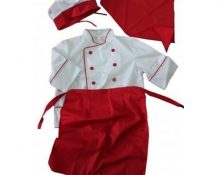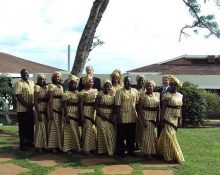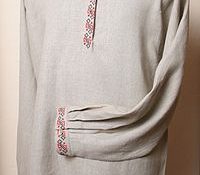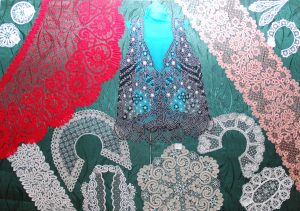
creativecommons.org
Today we will talk about the legendary Kukar lace: how it appeared and what legends are associated with it. In this article we will tell you how you can make lace yourself if you are taking your first steps in lace making. At the end of the material you will find a visual pattern for beginners, as well as a description of the process.
What is kukar lace and why has it become so popular?
Kukarka lace is a folk craft that originated in the 18th century in the Kukarka area in the Kirov region. Today, the once former settlement has turned into a city and is called Sovetsk. Due to the fact that the craftswomen making Kukar lace lived on the Vyatka River and relatively close to another major trade route - the Volga, their goods were quickly distributed to fairs.High-quality goods became popular not only in Russia, but also abroad: Kukar lace was bought in Asia (including Japan) and in advanced European countries such as Great Britain, Holland, France and Sweden.
Unlike most other laces, working on Kukar lace involves painstakingly making the so-called “lattice,” a background weave that serves as the basis for the main floral pattern. Sometimes several types of such gratings are used in one product, which significantly affects the appearance of the product and its price. The fact that weaving kukar lace is a complex task is not just a figure of speech. Products made from Kukar lace are exhibited at exhibitions at the State Tretyakov Gallery in Moscow and at the Russian Museum in St. Petersburg.
History of Kukar lace
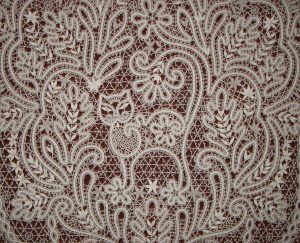
creativecommons.org
Kukar lace appeared in the 18th century in the Kirov region in the Kukarka settlement of the same name and almost immediately became a symbol of the region. There is a beautiful legend that Kukar lace appeared partly thanks to the misadventures of a noble carpenter, who was sent by personal order of Peter I to study shipbuilding. In Holland, he married a local girl, and when the time came to return to Russia, he took his wife with him. Upon arrival at his homeland, he was sent to Voronezh, but there he fell out of favor and was forced with his wife to flee the city, hiding in the Vyatka forests, and later settled in the Kukarka settlement. To earn a living, he worked as a carpenter, and his wife weaved lace and taught it to local women.This legend echoes another legend, according to which Emperor Peter I, in order to develop handicraft lace production, ordered craftswomen from European monasteries who could teach Russian peasants their craft.
But the truth about the origin of Kukar lace is most likely much more prosaic. The basis for Kukar lace was samples of Vologda lace that came to the settlement from Veliky Ustyug. First, the craftswomen figured out how to repeat the designs and began to copy other people’s chips, and then they complicated the pattern and began to come up with their own innovations. In the works of the craftswomen, Vologda and Yelets motifs of drawing could be traced every now and then. But by the 1800s, its own style had formed: complex background couplings, stylized flowers, intertwining with each other and forming a single complex ornament of the product. Kukar lacemakers wove mainly from linen and silk threads, and less often worked with cotton. By the 1870s, Kukarka lace overtook Vologda lace in terms of sales volumes, and the craftswomen of the Kukarka settlement received more than in Vologda. In 1872, Kukar lace participated in one of the Moscow Polytechnic exhibitions, and ten years later, samples were already exhibited at the Moscow All-Russian Industrial and Art Exhibition in all its diversity: lace collars, napkins, scarves, lace sleeves, cuts for decorating bed linen and tablecloths. By 1880, about 500 craftswomen were already weaving lace from blanks (few could make original designs, so most worked from ready-made chips). Soon, Kukar lacemakers began to make small items for the royal family: dresses, bedspreads, tablecloths and decorative napkins.By the end of the 19th century, samples of lace began to appear at international exhibitions and were even able to receive medals at exhibitions in Brussels, Paris and Atlanta. After such success, an official school of lace makers opened in Kukarka, which was renamed during the Soviet years (like the name of the city). During the war, lace making was abandoned, but in 1946, the Kukar lace school was reopened in the same area, the first stream of which amounted to more than 800 people. During the years of perestroika, the school and its production were closed and the trade relied exclusively on craftswomen who sewed at home. Kukar lace is still made today, although it is less popular.
What you will need to create kukar lace:
- Wooden stand with two cross frames
- Tambourine pillow or roller filled with sawdust
- Pillowcases for pillows or cushions (it is important to change them enough so that the lace does not get dirty)
- Sample chip for beginners presented in this article
- Bobbins, from 50 to 100 pieces
- A piece of foam
- Graph paper
- Crochet hook and pricking needle
- Pins
- Threads from different materials
- Case for work. Since bobbin weaving takes a long time, craftswomen always hide their work from dust and dirt.
Step-by-step master class on weaving kukar lace at home
Let us immediately warn you that it is impossible to explain in words exactly how lace is woven, so it is best to turn to visual video courses in parallel with reading our article. In general, to simplify as much as possible, there are only two actions in bobbin weaving: weaving and interlacing. Intertwine is throwing the right bobbin over the left in one hand, and weaving is the same action, but performed with bobbins in different hands.There is nothing complicated in the technique itself, but the weaving process is long and requires high concentration.
Here we will briefly describe the progress of the work:
- The chip, transferred to graph paper and secured to foam plastic, is attached to the work surface.
- Preparation of bobbins: threads are wound on them, and the bobbins themselves are attached to the working surface with pins and fixed in the places where the pattern will begin.
- Some people recommend copying the chip yourself in order to feel the movement of the canvas and mark the injection points.
- Then you can start weaving, relying on the weaving pattern. The main thing is not to forget to hide the tails of the threads in the knitting so that it does not unravel.
- All weaving consists solely of weaving and throwing, and the craftswoman herself only needs to methodically follow the weaving instructions and practice her hand.
Where can kukar lace be used?
At first glance, it seems that folk crafts, in particular Kukar lace, are a relic of the past. However, lace inserts can still be relevant for evening dresses. Thus, capes made of kukar lace are especially popular. If you take materials of dark colors (for example, black, brown or dark blue), then this item of clothing will be quite practical and wearable, and the quality will not be inferior to Italian products. Kukar lace looks very original, woven into a scarf so that part of it consists of fabric, and part of lace, repeating the pattern.


 0
0